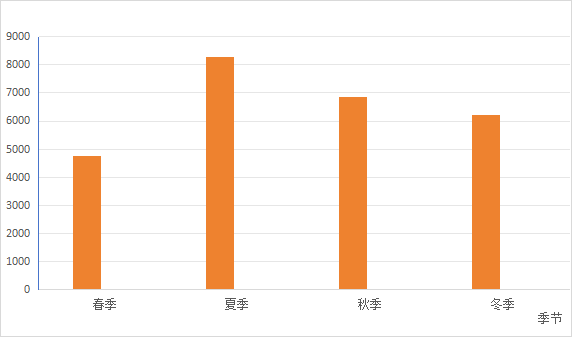
国外相关数据显示,OE每年约占美国急诊科就诊次数的15.37%[6];一项基于全国数据描述美国急诊科眼科服务使用情况的研究显示,在美国仅有41.2%的OE就诊是针对紧急问题,而44.3%是针对非紧急问题,如结膜炎等[2];在我国,OE患者约占10.24%~13.58%[7]。尽管资源有限,但OED仍面临着提供有效临床护理日益增长的需求[2]。近年来,我国OE最常见的状态是患者的过度拥挤,这也显示出对急诊服务需求的增加以及流行季节患者数量的爆发。
疾病谱作为一种重要的公共卫生工具,能够清晰地展示在特定地域和时间框架内,各种疾病在人群中的发生频率、疾病类型及其演变趋势[8]。随着我国社会的持续进步,人口结构的多样化与生活方式的变迁,OE的疾病谱也越发复杂,已有研究表明,深入探究急诊疾病谱对于提升急诊救治效率、优化医护人员的专业培训及合理调配医疗资源等方面具有不可忽视的指导价值[9]。尽管国内外已有关于OE患者疾病种类与分布的初步研究[10-12],但当前针对OE患者流行病学的系统性研究仍显不足,且由于地区间经济发展水平、文化背景及生活习惯的差异,各地OE疾病谱的特征亦不尽相同。
本研究通过回顾性分析天津市某眼科专科医院急诊医学科疾病谱,深入了解天津地区眼科专科医院急诊患者的就医方式和疾病种类特性,为规范疾病诊断流程、合理分配急诊医疗资源及提高服务质量提供坚实的数据支撑与科学依据。
采用回顾性研究的方法,选取2019年1月—2023年12月天津市某眼科专科医院急诊科收治的26 077例患者为研究对象。纳入标准如下:1)符合急诊就诊的相应标准,由急诊科预检分诊护士通过询问患者主诉及病史后,依据我国卫生部颁布的卫生行业标准中《医院急诊科规范化流程》[13]及《急诊预检分诊专家共识》[14]确定病情等级,根据《急诊预检分诊标准》[15]及《眼科急诊预检分诊标准》[9]将患者病情严重程度分为Ⅰ~Ⅲ级。I级需立即诊治,主要包括24 h内突发双眼或单眼视力下降至无光感、眼部/眼周重度疼痛、未经处置过的化学物品入眼、眼外伤伴眼内容物脱出/异物嵌顿/流血不止,需在15 min内处理。Ⅱ级为7 d内进行性视力下降、眼部/眼周中度疼痛、简单处置后的化学物品入眼、未经处置过的、除Ⅰ级之外的眼外伤,需在30 min内处理。Ⅲ级指1个月内出现视力下降、眼部/眼周无或轻度疼痛,除上述外,其他病情稳定、症状轻微的眼部疾病,需在45 min内进行处理。2)病史资料记录完整。排除标准:1)已挂急诊号但后续退号的患者;2)仅在急诊科室开具药物或检查单,不符合急诊就诊条件的患者。本研究已获得天津市眼科医院伦理委员会的批准(批件号:KY-2525012),在研究实施前已取得患者知情同意。对研究对象资料严格保密,不泄露隐私。
数据来源于医院信息中心的医疗信息系统(Hospital Information System, HIS)系统,提取急诊患者相关信息,包括一般人口学资料,如患者性别、年龄;就诊时间、发病季节、初步诊断等。
使用SPSS 25.0统计软件构建数据库,并进行分析。OE患者病型构成比的描述中,计数资料以n(%)表示,采用χ²检验分析不同年份、季节、年龄的OE前10位诊断疾病的相关性,结果显示差异有统计学意义(P < 0.05)者采用Bonferroni事后检验进行组间多重比较。拟定双侧P<0. 05为差异有统计学意义。
2019年1月—2023年12月于我院急诊医学科首诊总人数为26 398人次,本次统计共纳入符合标准的患者26 077人次,占实际就诊人数的98.78%。男女比例为1.12∶1。就诊患者年龄最小者仅1月6天,最大者为122岁,年龄为(36.82±15.44)岁。就诊人数大多分布在<14岁及31~40岁年龄段,分别占总人数的26.74%及21.03%。见图1。

全年日间急诊接待患者共计14 016人次,占急诊总人数的53.75%;夜间急诊接待患者为12 061人次,占比为46.25%。
按时间分布,全天急诊就诊人次呈现出“三峰一谷”的特征;在3个高峰时段,就诊总人数达到8 317人次,占急诊总人数的31.89%。见(图2)

4月就诊人数最少,为1 008人次,占总人数的3.87%;8月就诊人数最多,为3 027人次,占总人数的11.61%。见图3。夏季就诊人数显著多于其他3个季节,春、秋、冬季就诊人数。见图4。


|
患者人数 |
构成比/% |
|
|
结膜炎 |
9 601 |
36.82 |
|
干眼症 |
3 185 |
14.32 |
|
角膜损伤 |
2 695 |
10.33 |
|
青光眼 |
1 655 |
6.35 |
|
角膜异物 |
1 992 |
7.64 |
|
睑腺炎 |
1 085 |
4.16 |
|
结膜下出血 |
778 |
2.98 |
|
眼挫伤 |
525 |
2.01 |
|
视网膜脱离 |
410 |
1.57 |
|
虹膜炎 |
308 |
1.18 |
|
总计 |
22 234 |
85.26 |
2019年1月—2023年12月OE患者前10种初步诊断季节分布具有统计学意义(P<0.001)。Bonferroni事后检验结果显示,与春季相比,其他季节OE患者前10种初步诊断显著下降(P 均< 0.001,夏季95%CI为-0.32~-0.08、秋季95%CI为-0.39~-0.14、冬季95%CI为-0.54~-0.30)。其中在结膜炎病例中,与春、夏季相比,冬季结膜炎病例分布呈显著下降趋势(P 均< 0.001,95%CI分别为-0.08~-0.03]、为-0.08~-0.04),春夏季疾病分布无统计学意义(P > 0.05)。见表3。
2.4.4 眼科急诊就诊患者前10种初步诊断不同性别间的差异
2019年1月—2023年12月OE患者前10种初步诊断性别分布具有统计学意义(P<0.001)。见表4。
2.4.5 眼科急诊就诊患者前10种初步诊断不同年龄间的差异
2019年1月—2023年12月OE患者前10种初步诊断年龄分布具有统计学意义(P<0.001)。Bonferroni事后检验结果显示,与14岁以下年龄段相比,其他年龄段OE患者前10种初步诊断均呈下降趋势,(P 均< 0.001,14~20岁95%CI为-0.88~-0.43、21~30岁95%CI为-1.01~-0.65、31~40岁95%CI为-1.10~-0.82、41~50岁95%CI为-0.97~-0.66、51~60岁95%CI为-1.71~-1.38、61~70岁95%CI为-1.45~-1.08、71~80岁95%CI为-1.36~-0.80、>80岁95%CI为-1.44,-0.22)。见表5。
|
年份 |
结膜炎[n(%)] |
干眼症[n(%)] |
角膜损伤[n(%)] |
青光眼[n(%)] |
角膜异物[n(%)] |
睑腺炎[n(%)] |
结膜下出血[n(%)] |
眼挫伤[n(%)] |
视网膜脱离[n(%)] |
虹膜炎[n(%)] |
χ²值 |
P值 |
|
2019年 |
3275 (51.82) |
680 (10.76) |
532 (8.42) |
406 (6.42) |
475 (7.52) |
332 (5.25) |
205 (3.24) |
171 (2.71) |
128 (2.03) |
116 (1.84) |
1 082.223 |
<0.001 |
|
2020年 |
43 (4.20) |
87 (8.50) |
176 (17.20) |
448 (43.79) |
61 (5.96) |
75 (7.33) |
48 (4.69) |
43 (4.20) |
28 (2.74) |
14 (1.37) |
||
|
2021年 |
258 (10.04)
|
478 (18.61) |
332 (12.92) |
652 (25.38) |
301 (11.72) |
197 (7.67) |
125 (4.87) |
98 (3.81) |
74 (2.88) |
54 (2.10) |
||
|
2022年 |
3466 (46.39) |
993 (13.29) |
882 (11.80) |
576 (7.71) |
707 (9.46) |
326 (4.36) |
249 (3.33) |
104 (1.39) |
88 (1.18) |
81 (1.08) |
||
|
2023年 |
1759 (36.27) |
947 (19.53) |
773 (15.94) |
373 (7.69) |
448 (9.24) |
155 (3.20) |
151 (3.11) |
109 (2.25) |
92 (1.90) |
43 (0.89) |
|
结膜炎[n(%)] |
干眼症[n(%)] |
角膜损伤[n(%)] |
青光眼[n(%)] |
角膜异物[n(%)] |
睑腺炎[n(%)] |
结膜下出血[n(%)] |
眼挫伤[n(%)] |
视网膜脱离[n(%)] |
虹膜炎[n(%)] |
χ²值 |
P值 |
|
|
春季 |
1773 (43.96) |
867 (21.50) |
336 (8.33) |
267 (6.62) |
365 (9.05) |
136 (3.37) |
103 (2.55) |
68 (1.69) |
57 (1.41) |
61 (1.51) |
483.605 |
<0.001 |
|
夏季 |
3189 (44.23) |
939 (13.02) |
939 (13.02) |
515 (7.14) |
605 (8.39) |
383 (5.31) |
286 (3.97) |
179 (2.48) |
109 (1.51) |
66 (0.92) |
||
|
秋季 |
2423 (46.76) |
540 (10.42) |
561 (10.83) |
358 (6.91) |
510 (9.84) |
268 (5.17) |
180 (3.47) |
159 (3.07) |
98 (1.89) |
85 (1.64) |
||
|
冬季 |
1416 (24.38) |
839 (14.44) |
859 (14.79) |
1315 (22.64) |
512 (8.81) |
298 (5.13) |
209 (3.60) |
119 (2.05) |
146 (2.51) |
96 (1.65) |
|
结膜炎[n(%)] |
干眼症[n(%)] |
角膜损伤[n(%)] |
青光眼[n(%)] |
角膜异物[n(%)] |
睑腺炎[n(%)] |
结膜下出血[n(%)] |
眼挫伤[n(%)] |
视网膜脱离[n(%)] |
虹膜炎[n(%)] |
χ²值 |
P值 |
|
|
男性 |
4203 (38.53) |
1556 (14.27) |
1399 (12.83) |
858 (7.87) |
1275 (11.69) |
509 (4.67) |
397 (3.64) |
336 (3.08) |
212 (1.94) |
162 (1.49) |
166.028 |
<0.001 |
|
女性 |
4598 (40.59) |
1629 (14.38) |
1296 (11.44) |
1597 (14.10) |
717 (6.33) |
576 (5.09) |
381 (3.36) |
189 (1.67) |
198 (1.75) |
146 (1.29) |
本研究共纳入2019年1月~2023年12月在天津市某眼科专科医院急诊科就诊的26 077例患者,男女比例为1.12∶1,OE就诊患者的年龄为(36.82±15.44)岁。这与Channa等[2]的研究结果一致,可能是因为相较于非创伤性就诊,男性患者和青壮年(年龄在31~40岁)在创伤性就诊中出现的频率更高。这或许与特定年龄段的群体特征相关。青壮年作为主要劳动力,更频繁地从事高风险、一线劳动,因此接触各种危险因素的机会增多;同时,该年龄段人群可能因争强好胜的心理,更易卷入打架斗殴等事件,从而增加了眼外伤的发生率[11]。
根据全天候就诊人次的统计分析,呈现出“三个高峰一个低谷”的显著特征:就诊高峰时段分别为10:00~12:00、14:00~16:00以及20:00~22:00,这与林琪[16]等的研究结果一致,而就诊低谷则出现在05:00—07:00期间,这也与张少辉[17]等的研究结果一致。这种“三峰一谷”的就诊人次分布特征,主要受到多种社会和生理因素的影响。首先,10:00—12:00和14:00—16:00这两个高峰时段,通常与工作日的午休时间和下午工作结束时间相吻合。在这两个时间段,许多上班族和学生有空闲时间,可以利用这段时间前往医院就诊,处理个人健康问题。此外,这两个时段医院的运营效率较高,医生和护士的精力相对充沛,能够提供更高效的服务,因此患者更倾向于选择这两个时段就诊。其次,20:00—22:00的就诊高峰,主要与下班后的时间相关,并且该时间段为门诊停诊时间,使患者集中涌入急诊[18]。对于那些白天工作繁忙,无法抽身的患者,他们更倾向于在下班后前往医院就诊。这个时间段,虽然医院的运营效率可能有所下降,但由于患者在白天积累了较多的健康问题,因此就诊需求仍然较高。至于05:00—07:00的就诊低谷,这主要与人们的睡眠习惯有关。在深夜,大多数人都处于睡眠状态,除非出现严重的健康问题,否则很少有人会选择在这个时间段就诊。综上所述,全天各时间段就诊人次的分布特征,是社会生活习惯、个人健康需求与医院运营效率相互作用的结果。
提示我们可以采取相关措施优化资源配置,提升患者就诊体验。首先,针对就诊高峰时段,医院应增加医护人员排班,特别是在10:00—12:00、14:00—16:00及20:00—22:00这三个时间段,确保有足够的医生和护士在岗,以减少患者等待时间,提高就诊效率。其次,对于就诊低谷时段,即02:00—06:00,医院可以适当调整夜间值班人员的数量,确保紧急情况下的医疗服务不受影响,同时也能合理控制夜间运营成本,还可运用大数据进行分析[19],了解不同时间段就诊患者的疾病类型和需求,有针对性地调整科室的开放时间和人员配置。
本研究显示,与2019年相比,2020年和2021年OE就诊患者人数明显降低,急诊就诊总量显著减少,其中以结膜炎和干眼症的就诊量减少尤为明显,2022年有一定程度的恢复。这与国内外相关研究结果一致[7,20-21]。自2019年12月起突发的公共卫生事件,对医疗卫生系统特别是医院急诊科的运行模式产生了显著影响。本研究发现,在公共卫生突发事件期间,急诊科就诊患者呈现明显的选择性特征:仅急危重症患者倾向于选择急诊就医,而部分患者因担忧院内交叉感染风险而延迟就诊,导致病情延误。这一现象可能与以下因素有关:首先,公共卫生突发事件期间严格的感染防控措施增加了就医难度;其次,患者对疫情风险的顾虑超过了对自身疾病的重视程度[22]。具体而言,轻症眼表疾病(如结膜炎)和眼睑疾病患者更倾向于采取居家观察、线上咨询或自我药疗等替代性医疗行为,这直接导致OE就诊率下降[23]。此外,居家隔离期间,眼表微小异物伤和早期眼睑泪器疾病往往不易被及时发现,增加了疾病进展和并发症发生的风险。
3.3.2 眼科急诊就诊患者前10种初步诊断不同季节间的差异
本研究显示,与14岁以下年龄段相比,其他年龄段OE患者前10种初步诊断均呈下降趋势。提示在OE患者前10种初步诊断中,14岁以下年龄段人群相比来说有较高风险。这与国内外研究较为一致,结膜炎在儿童中尤为常见且随着年龄的增长,儿童结膜炎患病率逐渐上升[29-30];14岁以下人群干眼症发病率较高[31-33];眼外伤的高发人群为7~14岁,以青少年居多[34-35]。由于青少年认知发展尚未成熟,其强烈的好奇心与有限的风险评估能力形成显著反差,加之自我保护意识薄弱,导致眼外伤发生率显著升高[36];其次,随年龄增长,学业压力增大与视频终端使用频率增加等因素叠加,易引发视觉负荷过重,破坏泪膜稳态[37],从而导致干眼症发病率上升。基于上述发现,建议采取以下干预措施:在眼外伤预防方面,应重点加强对14岁以下青少年及其监护人的健康教育,强化危险物品管理制度,明确监护责任,通过安全知识普及提升自我保护能力;在结膜炎防控方面,需注重家庭环境卫生管理,培养儿童良好的个人卫生习惯,如规范洗手、定期消毒个人用品等,并在流行季节严格落实隔离防护措施;在干眼症预防方面,应指导儿童科学使用视频终端,控制用眼时长,同时采取必要的防护措施以减少紫外线等环境因素对眼表组织的损伤。
本研究通过对2019年1月—2023年12月的急诊眼科就诊进行回顾,发现结膜炎和干眼症是急诊中最常见的眼部诊断。本研究结果显示,2019年1月—2023年12月OE就诊患者的首要诊断主要是那些通常被认为是非紧急的诊断。既往研究也报告了急诊紧急护理服务的非紧急就诊率。来自巴西的一项研究报告称[38],一家三级转诊中心的紧急眼科护理显示,69%的病例只需要简单的治疗。一所美国大学转诊中心的另一项研究也报告称[39],超过三分之一的患者病情并不紧急。本研究结果与既往研究一致。这些非紧急医疗就诊的增加可能是导致急诊过度拥挤的主要原因,这也会造成对其他有更紧急医疗问题的患者的就诊和护理延误。
据美国医学院协会预测,到2034年,医护短缺将在37 800~124 000人。鉴于此,在现有情况下精简医护的时间和精力是至关重要的。解决OE过度利用问题是改善OE护理的必要挑战。这就要求我们,要引导患者更新就诊观念,清晰界定急诊科的服务定位。一方面,民众固有的“有病必赴大医院”“急诊非急”的观念转变不易[40],亟须政府、地方卫生管理部门及大型医疗机构加大急诊医学的科普力度,倡导公众形成科学的就医意识,深刻理解急诊“急、危、重”的特性。另一方面,鉴于当前医院急诊科难以拒收“非急症”患者[41],建议政府明确界定急诊接收病患的范围,排除非紧急救治需求,或对非急诊患者实施医疗服务费用上调,包括提高急诊挂号费、诊疗费等基础费用,以经济杠杆为调控,从根源上减少入口环节的患者数量。
在先前的几项研究中[42-44],已经有学者提出通过急诊护士进行预检分诊[45],加强引导,将非紧急病例有效分流至日间门诊,作为缓解急诊室过度拥挤的有效策略。同时,考虑在工作日提供门诊延时服务(即夜诊服务)直至晚上8时,以满足“上班族”在晚间时段的就医需求。此外,应切实执行分级诊疗制度[14],促进患者在不同层级医疗机构间的双向流动。通过广泛开展公众健康教育,倡导非急症患者优先选择日间门诊、社区卫生服务中心及其他基层医疗卫生机构就诊,进一步完善初级诊疗体系与双向转诊机制,确保急诊科的医疗资源能够精准服务于真正有紧急需求的患者群体。
综上所述,本研究通过回顾性分析2019年1月—2023年12月OE就诊患者的资料,总结5年间OE就诊患者人数变化情况及性别、年龄、就诊时间、发病季节、疾病初步诊断等分布情况,深入分析了天津地区OE疾病谱的构成及其动态变化特征。研究结果具有双重意义:其一,为该地区EED明确临床工作重点、优化医疗技术人员培养方案提供科学依据;其二,有助于掌握该地区医疗卫生服务现状,为制定常见病、多发病的预防控制策略提供管理参考,从而有效提升医疗服务质量和效率。此外,本研究还可为急诊学科的管理体系建设、临床培训方案优化以及急诊急救资源的合理配置提供理论指导,有助于急诊工作重点的科学规划,进而推动急诊医学的可持续发展,更好地适应当代急诊医学的发展需求。


点击右上角菜单,浏览器打开下载